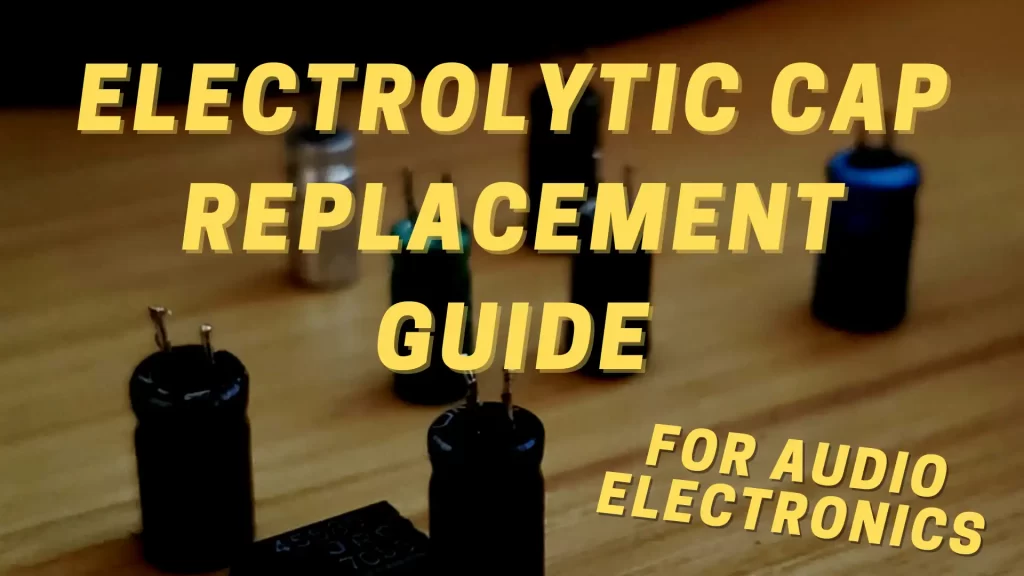
Often times you will need to specify, purchase, and replace electrolytic capacitors when dealing with audio electronics. Whether you are building audio circuits, or repairing vintage equipment, this is a necessary skill you need in your toolbox.
By the end of this article, you will know the most important factors you need to take into account when choosing an electrolytic capacitor replacement, as well as how to purchase one from an online electronics parts distributor.
As a member of the Reverb Partner Program and as an Amazon Associate, StompboxElectronics earns from, and is supported by, qualifying purchases.
Disclaimer: Stompbox Electronics and/or the author of this article is/are not responsible for any mishaps that occur as a result of applying this content.
Symptoms of a Bad Electrolytic Capacitor
In my experience, there are three main symptoms of bad electrolytic capacitors:
- Bulge Formation
- Dielectric Leakage
- Non-Visual Symptoms
Let’s look at each one in more detail.
Bulge Formation
Electrolytic capacitors are manufactured in aluminum packaging that resembles a metal “can.” In radially leaded capacitors, the top of the can is where the aluminum is folded in to seal in the dielectric material.
If a capacitor goes bad that material expands and can push on the seal, leading to a bulging formation on the top of the cap. Looking from the side, you can usually see a bump at where the seal is located.
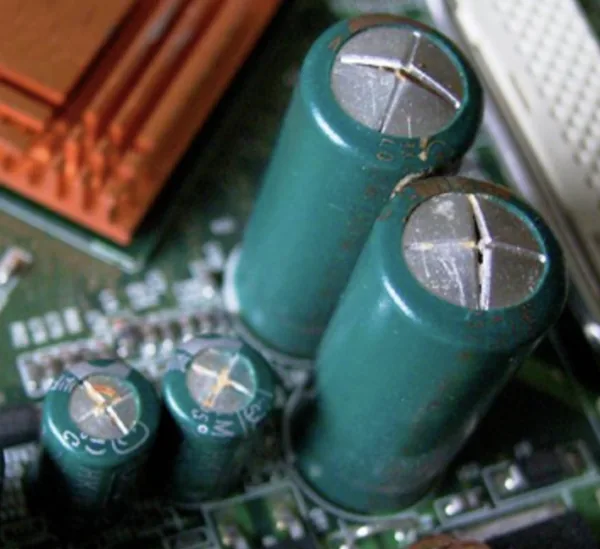
Dielectric Leakage
When manufactured, the dielectric inside an electrolytic capacitor is a viscous substance. If a capacitor fails, that substance can spray or leak out of the aluminum can.
To find leakage on caps with a radial termination style, inspect the top of the metal can. Check the bottom of the can, too, as it could leak out from where the component leads protrude.
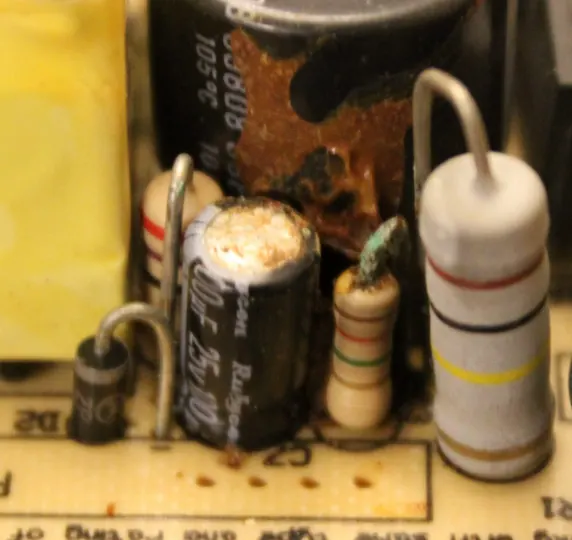
Non-Visual Symptoms
Over time the capacitor will slowly and steadily decline in efficiency as a result of the dielectric drying up. Capacitors that fail as a result of this inevitable cause may not show any visual symptoms. In this case, you may need to resort to more subtle detection methods.
For example, I once had a switching power supply fail on me. The problem was determined to be a group of bad capacitors, and the only symptom that manifested was in the form of heat on the outer aluminum package.
How To Test A Capacitor’s ESR
You can use a multimeter to quantify how “healthy” a capacitor is by setting it to resistance mode and checking the ESR (Equivalent Series Resistance). An ideal cap has an ESR of zero, but in reality, a healthy cap is associated with low ESR values.
The range of good ESR values is different for each capacitor/voltage rating combination. Generally, for large capacitors, an ESR of 0.1 ohms is considered low. For smaller caps, look for values below about 0.5 ohms. With experience, you will know what to look for given various cap ratings.
My personal tool of choice is the 2-in-1 Handheld Oscilloscope Multimeter, which has a setting for measuring resistance and another for capacitance. Plus, you can use it for measuring time-varying voltage, which is essential for audio electronics repair.
You may also benefit from having a dedicated ESR testing device, should as this Atlas ESR70 Capacitance and ESR Tester.
Characteristics of an Electrolytic Capacitor
Now that you know how to detect whether a capacitor needs to be replaced you can start to take note of the different characteristics you will need to look for when seeking a replacement. The following are the most important factors that you should write down for each capacitor you are replacing.
Capacitance
The capacitance is the most basic characteristic of a capacitor. It’s measured in Farads, usually in considerably smaller quantities like milliFarads (mF), microFarads (μF), nanoFarads (nF), or picoFarads (pF). For electrolytic caps, this is usually printed on the outside aluminum casing.
Voltage Rating
In my opinion, this is the most important characteristic when replacing a capacitor. It is the maximum voltage a capacitor can take before it starts misbehaving. Like the capacitance value, you will find this printed on the outer aluminum casing in Volts (V). Common voltages include 10V, 16V, 25V, 50V, 63V, etc.
Since this is a maximum rating, you have the option of replacing the bad capacitor with one having a larger voltage rating. Generally, you will want to replace it with an exact match since choosing one with a larger rating may result in a physically larger capacitor.
Termination Style
Electrolytic caps have two possible termination styles: Radial and Axial. Radial capacitors have both leads protruding from a single side of the package. Conversely, an axial capacitor has its leads extending from both ends. Radial caps are much more common than their axial counterparts. You can find axial caps more commonly in guitar or bass amplifiers.
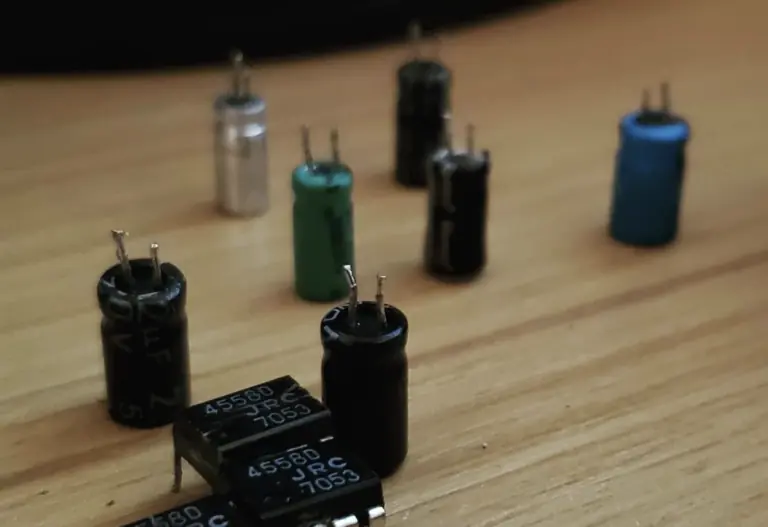
Dimensions
When you replace the capacitor, you need to make sure it will physically fit. There are two dimensions you will need to specify for the replacement: the length of the cylindrical body (h) and the diameter (d).

I usually measure these values with a digital caliper after having removed the capacitor from the circuit. If you don’t want to remove the cap just yet, you can just measure the diameter and that may be enough for when you look for a replacement part. Always measure these dimensions in millimeters (mm).
Lead Spacing / Pitch
The lead spacing, or pitch, of a radial electrolytic capacitor is the distance between its two leads. This value is usually measured in millimeters.
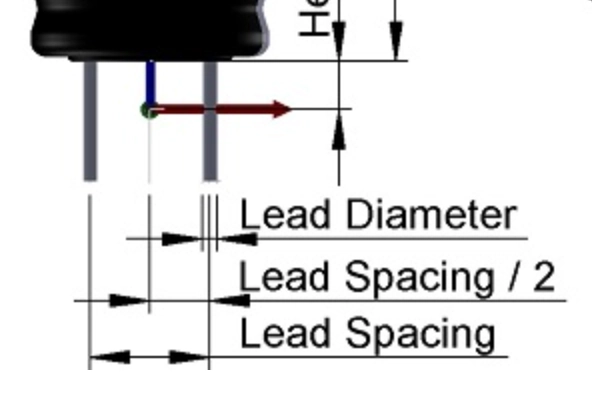
Finding Your Electrolytic Capacitor Replacement
In this article, we will use Newark to locate a replacement for a 10uF, 25V radially-leaded capacitor with a diameter of 6.3mm and lead spacing of 2.5mm.
First, head to the webpage to specify your replacement electrolytic capacitor. For us, it’s this page: https://www.newark.com/c/passive-components/capacitors/aluminium-electrolytic-capacitors/leaded-aluminium-electrolytic-capacitors.
You can also get there manually by selecting All Products -> Passives -> Capacitors -> Aluminum Electrolytic Capacitors -> Leaded Aluminium Electrolytic Capacitors.
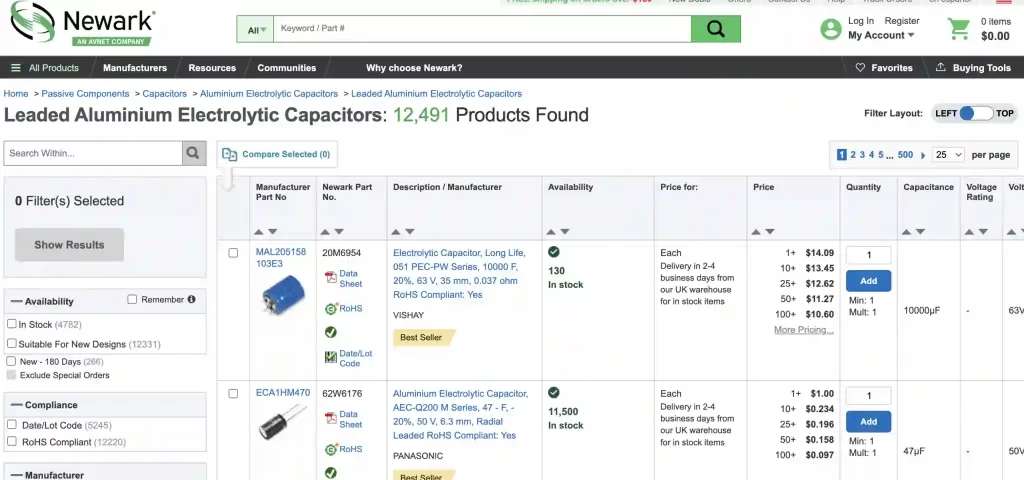
Narrowing Down Your Options
We are getting 12,491 products (at the time of writing this article, 2023). Let’s lower that number by filtering our results. You can do that by using the filtering options on the left-hand side of the screen. You can filter for the following factors:
- Capacitance
- Voltage Rating
- Capacitor Case/Package (Termination Style)
- Product Diameter
- Lead Spacing
- Product Height
In our case, choose 10uF for the capacitance value, 25V as the voltage rating, and Radial Leaded as the Capacitor Case/Package, then show the results. We’ve reduced the product count from 12,491 to 56…that helps!
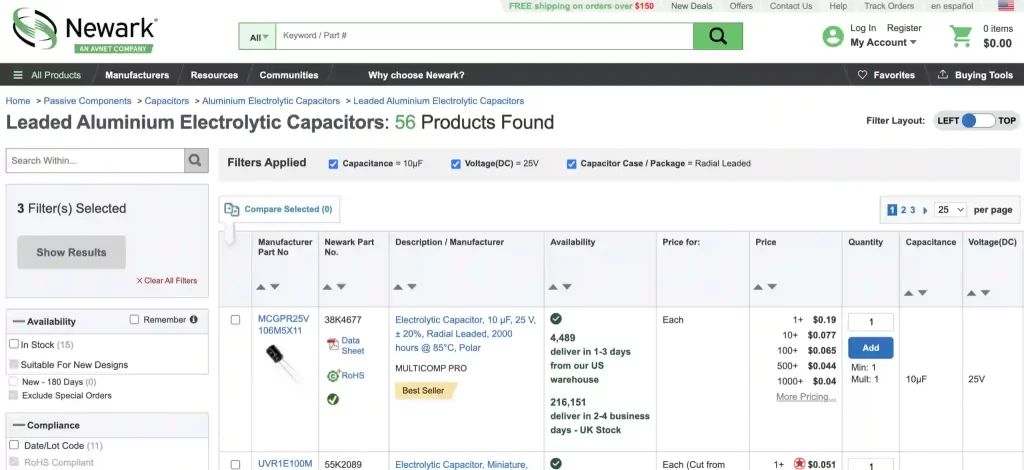
Adding in the 6.3mm diameter detail, we can narrow down our choices to only 2 products. One of the two options is not in stock (you can prevent this by checking the ‘In Stock’ box under Availability to the left).
It looks like the Panasonic ECA-1EM100 is what we are looking for.
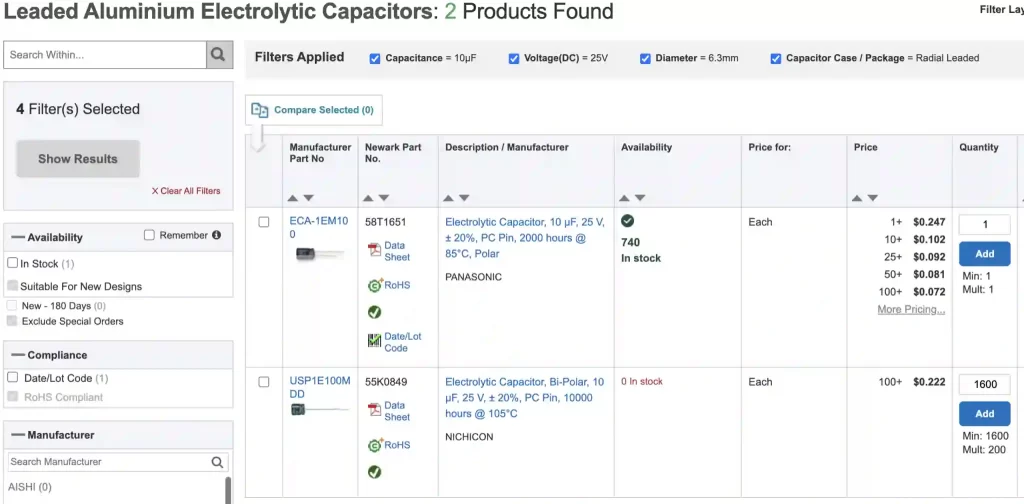
We need to make sure this part has the required 2.5mm lead spacing we need.
Click on the product link to land on the product page for the capacitor and scroll down. Look under the Product Information section to find the Lead Spacing value. In this case, we can see it is in fact 2.5mm and we can feel safe about purchasing this as a replacement for our repair job.
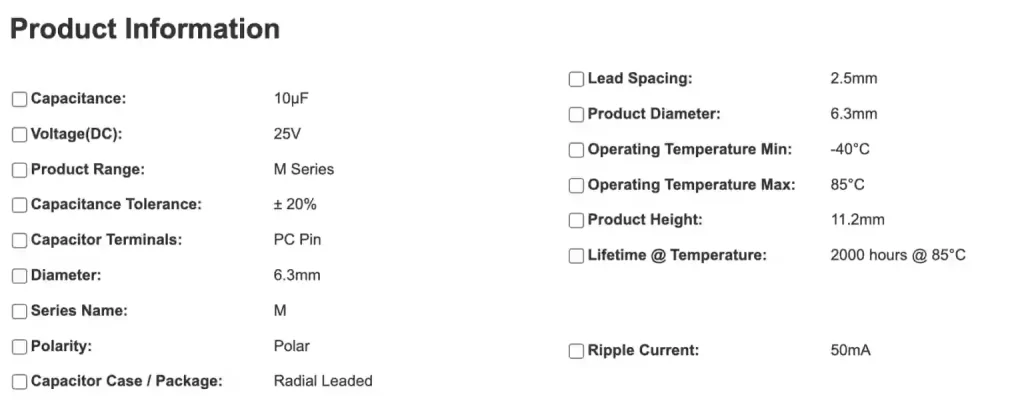
Replacing the Electrolytic Capacitor
So you have the replacement at hand and you’re ready to remove the old capacitor.
The first thing to do is reflow the solder. Use your soldering iron to melt the new solder onto the old solder. This will add flux to the solder pads and will help make the thermal profile more consistent.
Second, it’s time to remove the existing solder holding in the leads of the capacitor. There are three ways you can do this:
Once you’ve removed the old capacitor, it’s a good idea to clean the surface with isopropyl alcohol to make sure the burnt flux is removed. After ensuring the area is clean, you can install the new capacitor.
Electrolytic Capacitor Replacement FAQs
Usually, the power supply section of an audio circuit employs large electrolytic capacitors to reduce the voltage ripple left over from a previous stage in the power conversion process. The rectification stage, for example, produces large “humps” of voltage that must be smoothed into a constant value with a filter capacitor.
The short answer is yes.
If audio equipment is more than 15-20 years old, then it’s a good idea to start thinking about replacing the electrolytic capacitors to prevent imminent failure.
If you have the equipment, you could measure the ESR of each electrolytic capacitor and judge whether to replace them based on your measurements.
For large electrolytic capacitors a good ESR value would be less than 0.1 ohms. For smaller electrolytic capacitors, good ESR values are less than 0.5 ohms.
Generally the lower the ESR value, the healthier the capacitor.
My go-to distributors for electrolytic capacitors include Mouser, Digikey, Arrow, and Newark.
Yes, electrolytic capacitors have positive and negative polarity leads. The positive lead is designated by a plus sign, while the negative lead is designated by a minus sign.
Meet the Author:

Hi, I’m Dominic. By day, I’m an engineer. By night, I repair and modify guitar effects! Since 2017, I’ve been independently modifying and repairing guitar effects and audio equipment under Mimmotronics Effects in Western New York. After coming out with a series of guitar effects development boards, I decided the next step is to support that community through content on what I’ve learned through the years. Writing about electronics gives me great joy, particularly because I love seeing what others do with the knowledge they gain about guitar effects and audio circuits. Feel free to reach out using the contact form!
The Tools I Use
As a member of Amazon Associates, Stompbox Electronics earns and is supported by qualifying purchases.














